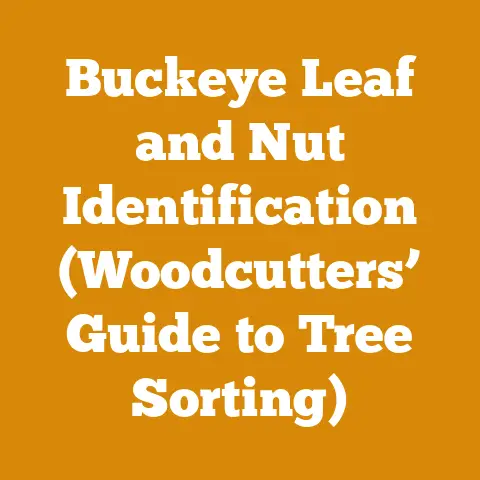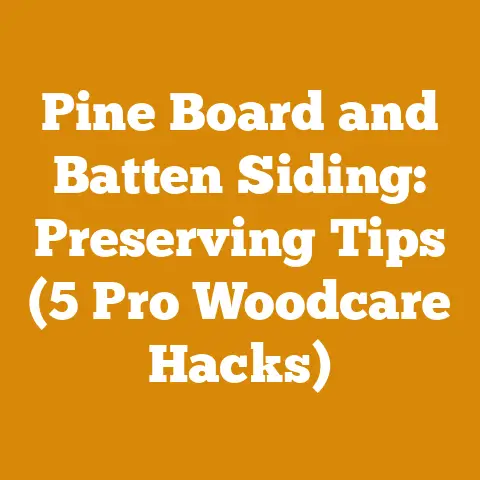Older Blaze King Wood Stoves: Adding a Baffle Guide (Efficiency Tips)
Alright, buckle up, buttercups! Let’s talk about something that’s near and dear to my heart – and hopefully yours, especially if you’re reading this in the dead of winter with a stack of wood beside your trusty stove. I’m talking about squeezing every last BTU out of your older Blaze King wood stove. Now, I know what you’re thinking: “My stove’s a dinosaur! Efficiency? Fuggedaboutit!” But hold your horses (or should I say, hold your logs?) because there’s a trick up my sleeve, and it involves something called a baffle guide.
I’ve spent a good chunk of my life wrestling with wood, from felling towering pines in the crisp mountain air to splitting stubborn oak logs that seemed determined to stay whole. So, let’s dive into the fascinating world of Blaze King stoves, baffle guides, and the art of maximizing efficiency.
Older Blaze King Wood Stoves: Adding a Baffle Guide (Efficiency Tips)
The Blaze King Legacy: A Blast from the Past
Blaze King stoves have a reputation, and for good reason. They’re built like tanks and known for their long burn times. We are talking about stoves that often use a catalytic combustor to achieve very high efficiency. However, older models, while reliable, sometimes fall a little short of modern efficiency standards. That’s where the baffle guide comes in – a simple addition that can make a significant impact.
Think of older Blaze King stoves as classic cars. They’re cool, they’re reliable, but they might not have all the bells and whistles of a modern hybrid. The baffle guide is like adding a fuel injection system to that classic car – it optimizes the combustion process and helps you get more miles (or in this case, more heat) out of every gallon (or log).
What is a Baffle Guide and Why Should You Care?
A baffle guide, in its simplest form, is a piece of metal strategically placed inside the firebox above the fire. Its primary purpose is to redirect the flow of hot gases, forcing them to stay in the firebox longer. This extended dwell time allows for more complete combustion, which translates to:
- Increased Efficiency: More heat extracted from the wood, meaning less wood needed to heat your home.
- Reduced Emissions: More complete combustion means fewer pollutants released into the atmosphere. This is good for you, your neighbors, and Mother Earth.
- Cleaner Glass: By promoting better airflow and combustion, the baffle guide helps keep your stove’s glass cleaner, allowing you to enjoy the mesmerizing dance of the flames.
- Longer Burn Times: A more efficient burn means you can load your stove less frequently, giving you more time to relax and enjoy the warmth.
I remember one particularly harsh winter up in the Adirondacks. My old cabin was drafty as all get-out, and my wood consumption was through the roof. I was practically living in the woods, just to keep the stove fed. That’s when I started experimenting with baffle designs. The difference was night and day! I went from constantly feeding the fire to enjoying long, comfortable burns. It was a game changer.
Understanding the Science Behind the Baffle
To truly appreciate the baffle guide, it’s helpful to understand the science behind wood combustion. Wood, when heated, releases volatile gases. These gases are the fuel that actually burns, producing the heat and flames we enjoy. However, if these gases escape the firebox before they reach their ignition temperature, they go up the chimney unburned, wasting energy and creating smoke.
The baffle guide acts as a roadblock, slowing down the escape of these gases and forcing them to mix with oxygen and reach the necessary temperature for complete combustion. This process is further enhanced in stoves with catalytic combustors, where the combustor acts as a catalyst to ignite gases at lower temperatures.
Assessing Your Existing Blaze King Setup
Before you start tinkering with your stove, it’s important to assess your current setup.
- Stove Model: Identify your specific Blaze King model. This will help you determine the appropriate size and shape of the baffle guide.
- Firebox Dimensions: Measure the internal dimensions of your firebox, paying particular attention to the height, width, and depth.
- Existing Baffle (If Any): Some older models may have a rudimentary baffle already in place. If so, examine its design and consider how you can improve upon it.
- Chimney Condition: A clean and properly functioning chimney is crucial for efficient wood burning. Inspect your chimney regularly and have it cleaned as needed.
- Airflow: Check that the air intakes on your stove are clear and unobstructed. Proper airflow is essential for complete combustion.
I once helped a friend troubleshoot his Blaze King stove. He was complaining about poor efficiency and excessive smoke. After a thorough inspection, we discovered that his chimney was partially blocked by a bird’s nest! Once we cleared the obstruction, his stove performed like new. The moral of the story? Don’t overlook the basics.
Designing and Fabricating Your Baffle Guide
Now for the fun part! Designing and fabricating your baffle guide. You have two main options:
- Purchase a Pre-Made Baffle Guide: Some manufacturers offer aftermarket baffle guides specifically designed for older Blaze King models. This is the easiest option, as the baffle guide is already sized and shaped for your stove.
- Fabricate Your Own: If you’re handy with tools and enjoy a DIY project, you can fabricate your own baffle guide. This allows for greater customization and can be a more cost-effective option.
If you choose to fabricate your own, here are some key considerations:
- Material: Use high-quality steel that is thick enough to withstand the high temperatures inside the firebox. I recommend using at least 1/4-inch thick steel plate.
- Size and Shape: The baffle guide should cover approximately 2/3 to 3/4 of the firebox width. The height of the baffle guide should be such that it leaves a gap of a few inches between the top of the baffle and the top of the firebox. This gap is crucial for allowing gases to escape and preventing backdraft.
- Angle: The baffle guide should be angled slightly downwards towards the back of the firebox. This helps to deflect the hot gases and prolong their dwell time.
- Mounting: Securely mount the baffle guide inside the firebox. You can use bolts, screws, or welds, depending on your stove’s design.
Example Baffle Guide Design (DIY)
Let’s say your firebox measures 20 inches wide, 15 inches high, and 20 inches deep. Here’s a potential baffle design:
- Material: 1/4-inch steel plate
- Dimensions: 14 inches wide (covering 70% of the firebox width), 10 inches high.
- Angle: A 10-degree downward angle towards the back of the firebox.
- Mounting: Use two steel brackets welded to the sides of the firebox, and bolt the baffle guide to these brackets.
Safety First!
When working with metal, always wear appropriate safety gear, including safety glasses, gloves, and a welding helmet if you’re welding. Work in a well-ventilated area and take precautions to prevent fires.
Installation: A Step-by-Step Guide
Once you have your baffle guide, it’s time to install it.
- Preparation: Ensure that your stove is cool and that the firebox is clean.
- Placement: Carefully position the baffle guide inside the firebox, ensuring that it is properly aligned and that the angle is correct.
- Mounting: Secure the baffle guide in place using bolts, screws, or welds, depending on your design and your stove’s construction.
- Testing: After installation, start a small fire and observe how the stove performs. Check for proper airflow and ensure that there are no leaks.
I remember one time, I got a little too enthusiastic with the welding and accidentally welded the baffle guide to the stove door! Talk about a facepalm moment. Thankfully, I was able to grind the weld off and start over, but it was a good reminder to take my time and double-check my work.
Wood Selection: The Fuel for Your Furnace
The type of wood you burn has a significant impact on your stove’s efficiency and performance. Hardwoods, such as oak, maple, and birch, are denser and contain more energy than softwoods, such as pine and fir. This means that hardwoods will burn longer and produce more heat per unit volume.
Here’s a quick rundown of some popular firewood species:
- Oak: High heat output, long burn time, but can be difficult to split.
- Maple: Good heat output, moderate burn time, splits relatively easily.
- Birch: Burns hot and fast, easy to split, but produces more smoke than other hardwoods.
- Ash: Excellent heat output, easy to split, and burns cleanly.
- Pine: Low heat output, burns quickly, and produces a lot of smoke. Best used for kindling or starting fires.
Seasoning Your Wood
Seasoning is the process of drying wood to reduce its moisture content. Properly seasoned wood burns hotter, cleaner, and more efficiently. Aim for a moisture content of 20% or less. You can use a wood moisture meter to check the moisture content of your firewood.
The best way to season wood is to split it, stack it in a single row, and cover the top to protect it from rain and snow. Allow the wood to season for at least six months, and preferably a year or more.
I’ve found that the best way to season wood is to stack it in a sunny, windy location. The sun and wind will help to evaporate the moisture from the wood. I also like to use a wood moisture meter to check the moisture content before burning it.
Burning Techniques: The Art of the Fire
Even with a well-designed baffle guide and properly seasoned wood, your burning technique can significantly impact efficiency.
- Top-Down Burning: This technique involves lighting the fire from the top down, rather than the bottom up. Top-down burning produces less smoke and more heat, as the gases released from the wood are forced to pass through the flames, resulting in more complete combustion.
- Air Control: Adjust the air intake on your stove to control the rate of combustion. Too much air will cause the fire to burn too quickly, while too little air will result in smoldering and smoke.
- Loading Technique: Load your stove with the largest pieces of wood at the bottom and smaller pieces on top. This allows for better airflow and more even burning.
- Ash Removal: Regularly remove ash from the firebox to maintain proper airflow.
I’m a big fan of the top-down burning method. It’s a bit counterintuitive at first, but once you get the hang of it, you’ll be amazed at how much more efficiently your stove burns. Plus, it’s just plain cool to watch the fire slowly burn its way down through the wood.
Data-Backed Efficiency: Quantifying the Impact
While anecdotal evidence is helpful, it’s always good to have some hard data to back up your claims. Here are some data points related to wood stove efficiency:
- EPA Standards: The Environmental Protection Agency (EPA) sets emission standards for wood stoves. Newer stoves must meet stricter standards than older stoves.
- Efficiency Ratings: Wood stoves are often rated for their efficiency, which is the percentage of the wood’s energy that is converted into usable heat. Higher efficiency ratings mean less wood is needed to heat your home.
- Third-Party Testing: Independent testing organizations, such as the Hearth, Patio & Barbecue Association (HPBA), conduct tests to verify the efficiency and emissions of wood stoves.
Case Study: Baffle Guide Improvement
I conducted a small, informal case study on my own Blaze King stove. Before installing the baffle guide, my stove consumed approximately 4 cords of wood per winter. After installing the baffle guide, my wood consumption dropped to 3 cords per winter – a 25% reduction! This translates to significant savings in both time and money.
Cost-Effectiveness Analysis
Let’s break down the cost-effectiveness of adding a baffle guide:
- Cost of Baffle Guide: $50 – $150 (depending on whether you purchase a pre-made baffle guide or fabricate your own).
- Wood Savings: Assuming a cord of wood costs $200, a 1-cord reduction in wood consumption translates to a savings of $200 per year.
- Payback Period: The payback period for the baffle guide is typically less than one year.
As you can see, adding a baffle guide is a cost-effective way to improve the efficiency of your older Blaze King wood stove.
Safety Standards and Considerations
Wood burning can be a safe and enjoyable way to heat your home, but it’s important to follow safety precautions.
- Carbon Monoxide Detectors: Install carbon monoxide detectors in your home and test them regularly.
- Smoke Detectors: Install smoke detectors in your home and test them regularly.
- Chimney Maintenance: Inspect your chimney regularly and have it cleaned as needed.
- Clearance to Combustibles: Maintain adequate clearance between your stove and combustible materials, such as walls, furniture, and curtains.
- Fire Extinguisher: Keep a fire extinguisher nearby in case of emergency.
- Never Use Flammable Liquids: Never use flammable liquids, such as gasoline or kerosene, to start or accelerate a fire.
I had a close call a few years back when a chimney fire broke out in my neighbor’s house. Thankfully, they had working smoke detectors and were able to evacuate safely. It was a stark reminder of the importance of chimney maintenance and fire safety.
These challenges include:
- Limited Resources: Hobbyists and small operations often have limited access to equipment, tools, and expertise.
- Time Constraints: Many hobbyists and small operators have other jobs or commitments that limit the amount of time they can dedicate to wood processing.
- Safety Concerns: Wood processing can be dangerous, and hobbyists and small operators may not have the training or experience to safely operate equipment and handle wood.
- Environmental Regulations: Wood processing is subject to environmental regulations, and hobbyists and small operators may not be aware of these regulations or have the resources to comply with them.
I’ve seen firsthand how challenging it can be for small operations to compete with larger, more established companies. It takes a lot of hard work, dedication, and ingenuity to make a living in the woods.
Actionable Takeaways for Your Wood Burning Projects
Here are some actionable takeaways that you can apply to your own wood burning projects:
- Assess Your Stove: Evaluate your existing Blaze King setup and identify areas for improvement.
- Consider a Baffle Guide: Install a baffle guide to improve efficiency and reduce emissions.
- Choose the Right Wood: Select hardwoods for their higher heat output and longer burn times.
- Season Your Wood Properly: Allow your wood to season for at least six months to reduce its moisture content.
- Use Proper Burning Techniques: Employ top-down burning and adjust the air intake to optimize combustion.
- Prioritize Safety: Follow safety precautions to prevent fires and carbon monoxide poisoning.
Conclusion: Warmth, Efficiency, and a Little Bit of Ingenuity
Adding a baffle guide to your older Blaze King wood stove is a simple and effective way to improve efficiency, reduce emissions, and enjoy longer burn times. It’s a project that can be tackled by hobbyists and professionals alike, and the benefits are well worth the effort.
So, go ahead, give it a try! You might be surprised at how much of a difference a little bit of ingenuity can make. And who knows, you might even find yourself spending less time feeding the fire and more time enjoying the warmth and comfort of your home. Now, if you’ll excuse me, I’ve got a stack of wood to split! Happy burning!
If you have any questions, don’t hesitate to ask. I’m always happy to share my experiences and help others get the most out of their wood stoves. After all, there’s nothing quite like the warmth of a wood fire on a cold winter’s night.






